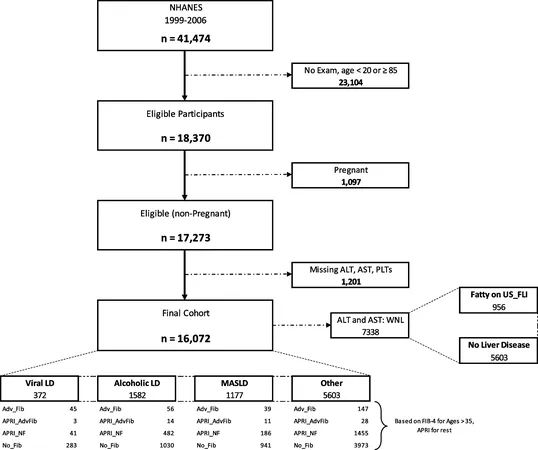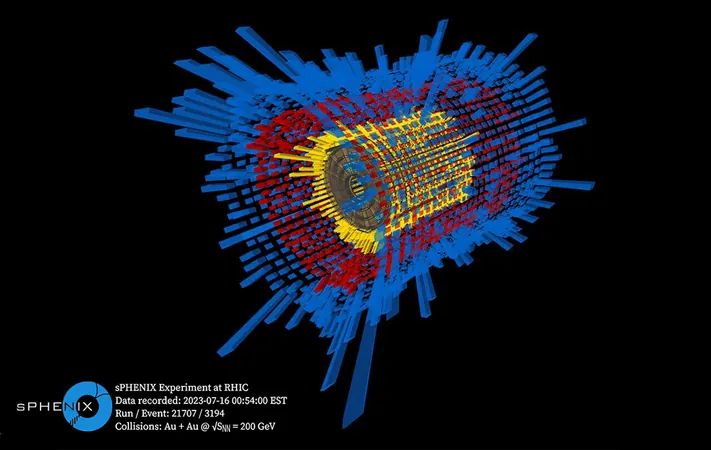
Unveiling Hidden Links: Sociodemographic Factors, Sarcopenia, and Mortality Among Liver Disease Patients in the U.S.
2024-11-11
Author: Mei
A groundbreaking study analyzing participants from the National Health and Nutrition Examination Survey (NHANES) has shed light on the complex relationships between sociodemographic disparities, sarcopenia, telomere length, and mortality in liver disease patients across the United States. This extensive research emphasizes the significance of understanding these intersections as we navigate the public health challenges surrounding liver disease.
Exploring the NHANES Database
The NHANES survey, ongoing since 1999, gathers critical health-related data from non-institutionalized civilian residents of the U.S. By focusing on participants from 1999 to 2006, researchers were able to establish a robust link between various health metrics, including sarcopenia, a condition marked by loss of muscle mass, which affects the quality of life and survival rates for individuals with liver disease.
Sarcopenia: A Widespread Concern
Sarcopenia was assessed through dual-energy X-ray absorptiometry (DEXA) scans, with significant findings emerging from a cohort of 8,891 patients with liver disease. Alarmingly, the condition was identified in approximately 9.5% of individuals, with elevated prevalence in those suffering from Metabolic Associated Steatotic Liver Disease (MASLD) at 18.4%. This new insight into sarcopenia highlights its relationship with the specific type of liver disease, indicating that targeted interventions may be needed to mitigate muscle loss among affected populations.
Impact of Sociodemographic Factors on Sarcopenia
The investigation exposed striking sociodemographic disparities. Age, education level, and physical activity were consistently linked to higher rates of sarcopenia. Individuals from minority ethnic backgrounds, particularly excluding non-Hispanic Black patients, exhibited a higher risk, suggesting a need for culturally sensitive healthcare strategies. Moreover, lower income levels and educational attainment were identified as major contributors to the increased likelihood of sarcopenia, underscoring the urgent need for public health efforts aimed at uplifting socioeconomically disadvantaged groups.
Mortality Risk and Telomere Length
Fascinatingly, the study also explored the role of telomere length—a biomarker associated with cellular aging—in influencing mortality risk. While patients with liver disease and sarcopenia demonstrated shorter telomeres, this didn’t play a significant role in predicting mortality when adjusted for age. However, the interactions between sarcopenia, telomere lengths, and age revealed intriguing dynamics. In younger individuals, shorter telomeres heightened mortality risk, especially among those with sarcopenia, while the reverse appeared to be true for older patients. This nuanced relationship could have major implications for monitoring and treating patients effectively.
Addressing Health Disparities
The findings accentuate the pressing need to address health disparities associated with liver disease by implementing interventions that target social determinants of health. Strategies aimed at enhancing physical activity levels and nutritional support could mitigate sarcopenia’s prevalence among vulnerable populations.
Conclusion: A Call to Action
This comprehensive study opens the door to further exploration of sarcopenia, telomere dynamics, and demographic impacts among liver disease patients in the U.S. Moving forward, healthcare providers are called to integrate these findings into practice, prioritizing not just medical treatment, but also broader socioeconomic factors to improve patient outcomes. With the battle against liver disease intensifying, understanding these correlations could serve as a crucial step toward enhancing life quality and longevity among affected individuals. Let's aim for a future where no one is left behind in the fight against sarcopenia!



 Brasil (PT)
Brasil (PT)
 Canada (EN)
Canada (EN)
 Chile (ES)
Chile (ES)
 Česko (CS)
Česko (CS)
 대한민국 (KO)
대한민국 (KO)
 España (ES)
España (ES)
 France (FR)
France (FR)
 Hong Kong (EN)
Hong Kong (EN)
 Italia (IT)
Italia (IT)
 日本 (JA)
日本 (JA)
 Magyarország (HU)
Magyarország (HU)
 Norge (NO)
Norge (NO)
 Polska (PL)
Polska (PL)
 Schweiz (DE)
Schweiz (DE)
 Singapore (EN)
Singapore (EN)
 Sverige (SV)
Sverige (SV)
 Suomi (FI)
Suomi (FI)
 Türkiye (TR)
Türkiye (TR)
 الإمارات العربية المتحدة (AR)
الإمارات العربية المتحدة (AR)